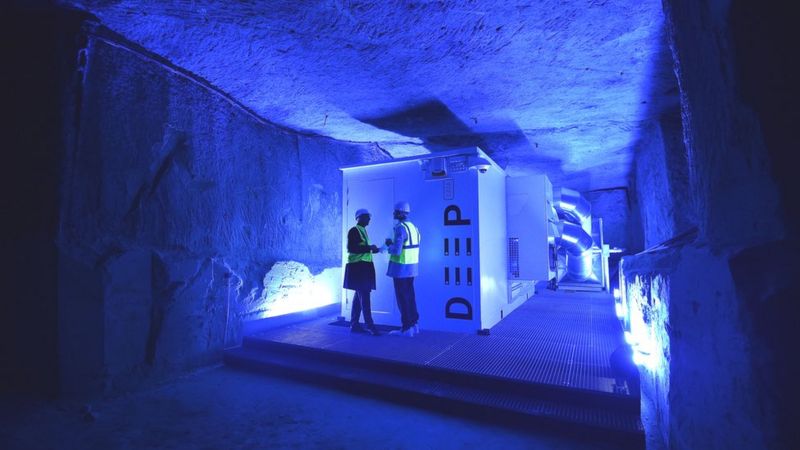
Industry News - Is our habit of watching TV shows harmful to the environment?
We continue to introduce you to the latest interesting news from the world of industry in the framework. Today - the impact of watching streaming video on climate change.
Watching your favorite TV show or listening to a playlist has never been easier.
A virtually endless supply of movies, music and TV programs can be streamed and downloaded instantly.
But at what cost to the environment?
It takes a huge amount of energy to provide data transmission on the Internet, and the demand will only grow as our dependence on digital services grows. Some of this energy comes from clean energy sources, but most of it comes from burning carbon-based fossil fuels, which scientists say is a contributing factor to the global rise in temperature.
The latest report from climatologists demonstrates the magnitude of the dangers faced by carbon emissions.
“How we power our digital infrastructure is rapidly becoming critical to our ability to stop climate change in time,” said Gary Cook, IT sector analyst at Greenpeace.
 So, can reducing time spent on the Internet really affect energy consumption and global warming?
So, can reducing time spent on the Internet really affect energy consumption and global warming?
By some estimates, the entire information technology (IT) sector - from powering internet servers to charging smartphones - has the same carbon footprint as the fuel emissions from the aviation industry. According to Anders Andre, who works at Huawei Technologies, by 2030 it will consume up to 20% of the world's electricity. Streaming video accounts for the largest portion of the world's internet traffic.
Watching video over the Internet at home is about the same as turning on two or three old-fashioned incandescent bulbs, according to professors at the University of Bristol's Computer Science Department.
In addition to the power used by these devices, energy is consumed by the networks that distribute the content.
The increased demand for technology also means more energy is required to store and exchange huge amounts of information.
This is where data centers come in - often in huge buildings that house computer servers that store, process, and distribute Internet traffic. The servers themselves require strong cooling.
Most of the world's internet traffic goes through these data centers and hosts streaming platforms such as Netflix, Facebook, and YouTube.
It is estimated that these data centers currently consume at least 1% of the world's electricity annually, and this figure is expected to grow in the future. They also account for about 0.3% of global CO2 emissions. Data centers being built around the world must be powered by renewable sources to minimize these emissions. The Eureca project, funded by the European Commission, showed that data centers in EU countries consumed 25% more energy in 2017 compared to 2014. The 5 (!!!) billion downloads and plays of Despacito, released in 2017, consumed the same amount of electricity as Chad, Guinea-Bissau, Somalia, Sierra Leone and the Central African Republic combined!
What exactly can we do to improve the situation?
Every time you sit down to watch or listen to something on the Internet, the amount of energy consumed is different. This depends on a number of factors, including the efficiency of the device. Terrestrial broadcast television is much more efficient than existing streaming technologies for TV channels that are watched by large numbers of people. Mobile phones are the most energy efficient - more than a TV or laptop. It also depends on how you "stream". A mobile phone using Wi-Fi consumes less power than a mobile phone connected to 3G or 4G. Even if you are not using your device, while your home Wi-Fi is active, you still consume energy. In the home, most of our energy consumption comes from the fact that we all have network equipment running around the clock.
 Storing Data Centers Underground Helps Cool Servers Some data centers can be more efficient than others. Storing them in cooler locations, such as underground, can reduce the large amount of energy needed for cooling.
Storing Data Centers Underground Helps Cool Servers Some data centers can be more efficient than others. Storing them in cooler locations, such as underground, can reduce the large amount of energy needed for cooling.
The latest report from the International Energy Agency (IEA) says that despite the increased load on data centers, which will triple by 2021, the amount of electricity used will grow by only 3%.
This is due to continuous improvements in the efficiency of servers and data center infrastructure, as well as the move to larger, but more efficient centers.
Some large tech companies have been praised for being more open about their effectiveness. Facebook expects its new data center in Singapore to be 100% renewable, which Apple says is already happening with all of its global facilities. Many other firms are committed to achieving this goal.
Companies are also offsetting the amount of non-renewable energy consumed by supporting renewable energy projects.
Researching lesser known and smaller companies and their energy use should be a priority. More attention needs to be paid to small data centers that are out of sight, this is the next big opportunity to save energy, big players aware of the growing problem are not so bad by comparison.
Source - https://www.bbc.com
